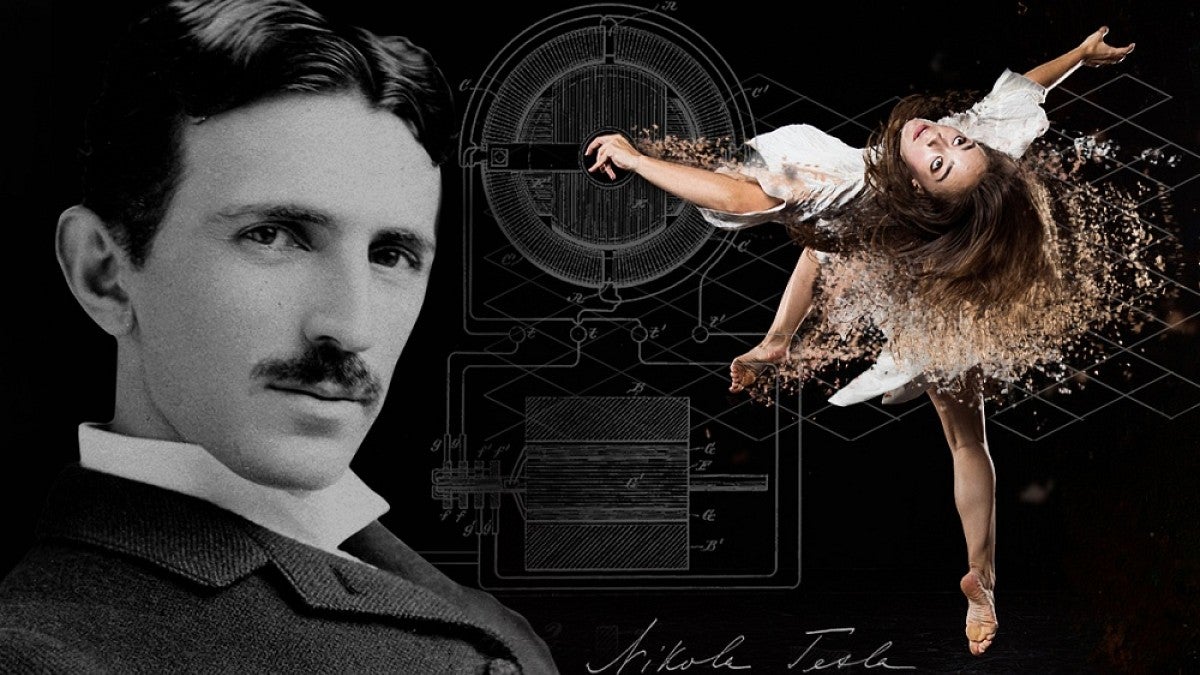Super-inventor Nikola Tesla pursued discoveries with such single-minded purpose that on occasion he went for days on only a couple hours of sleep.
He went on to develop the technology behind historic breakthroughs such as the way electricity is delivered over power lines and remote control. But Tesla was also glaringly overlooked, especially when compared with his contemporary Thomas Edison, a fierce rival of his.
And that’s partly why faculty members from the UO School of Music and Dance and the arts and physics departments came together to create “Tesla: Light, Sound, Color,” a stage show about this oft-misunderstood genius.
“We want people to know that when they hear the word ‘Tesla,’ they shouldn’t just think of a car,” said associate professor of dance Brad Garner, citing the popular electric car company of the same name. “He should be remembered and celebrated.”
The idea for “Tesla” began with Garner; John Park, a senior career instructor in the Department of Art; Jeremy Schropp, also of the Department of Art and who earned a doctorate in music composition and theory at the UO; and Jon Bellona, an instructor of audio production at the music school. The four men comprise Harmonic Laboratory, an artistic group that, among a range of other programs, holds performances and workshops incorporating multiple expressions of art.
But the group wanted to incorporate a strong science element into the show, too, in part to reach a broader audience. So they pulled in Stan Micklavzina, a senior instructor in the physics department.
“I’ve always had this idea of physics and performance, where people are going to come and see the performance, but then you throw the physics in with the performance,” said Micklavzina, who is popular in his own right for his high-energy physics demonstrations.
The group created a 90-minute show that includes dance, an original score, animation, science demonstrations and more. They will perform Jan. 10 and 11 at the Hult Center in Eugene, and then head to Portland on Jan. 13 and Bend on Jan. 15.
Bringing a group together with such a diverse mix of skills to tell Tesla’s story makes sense, Micklavzina said.
“It’s extremely appropriate because Tesla’s an interesting character in many aspects,” Micklavzina said, “a very complicated person.”
The members of Harmonic Laboratory began tossing around the idea for such an ambitious show five years ago. Focusing on Tesla seemed obvious the more they thought about it.
“We needed a story to link into,” said Park, who designs animations and multimedia projections for the group. “We talked about all the different physicists, and Nikola Tesla has a fascinating tale, a classic underdog story.”
Their plan took off last year when they received a $75,000 “Creative Heights Award” from the Oregon Community Foundation through Harmonic Laboratory’s affiliated nonprofit, Integrated Arts, to create and tour a stage show.
One of their hopes is to bring the traditionally separate audiences of the arts and sciences together.
“Music audiences, dance audiences, visual art audiences, science enthusiasts, they can all come and be exposed to other fields they may not normally follow,” Garner said.
The creators also believe this project is at the forefront of where education is heading.
“One reason we’re excited to share this is there’s been a lot of conversation about collaborating across disciplines on campus,” Garner said. “We want people to check it out as a potential model.”
“It’s almost like we’re inventing a new discipline where people can say, ‘Oh, you’re not just isolated over here, you don’t have to just be interested in physics or specialized in dance or music or digital art,’” Park added.
The effort resonates deeply with Park, whose father, Kwangjai Park, was a popular physics professor on campus for 35 years. He thinks it’s healthy to knock down any perceived barriers between the arts and sciences, and that the inability to excel at both is a myth.
“I’ve always wanted to combat this idea that scientists are only analytical, and the creatives belong over here,” Park said, motioning to the other side of the room. “I would love to show that these are not two different personality types.”
Kwangjai Park was also a mentor to Micklavzina, whose demonstrations range from riffing on an electric guitar to show how magnetism and electricity work to shooting lasers through fog to illustrate properties of light.
Micklavzina will explain the science behind the inventor’s findings. That includes one of Tesla’s most fascinating inventions: the Tesla coil, which fires off crackling, miniature lightning bolts. Tesla hoped it could one day transmit electricity to homes through the air. That never happened, but now it’s a useful tool to illustrate electrical concepts or to tell the story of the misunderstood scientist.
And Micklavzina can’t wait to see how it all comes together on the stage.
“It’s going to be an interesting experiment, and I’m pretty excited about it,” he said. “The whole thing is really an incredible assembly of people and talents.”
—By Jim Murez, University Communications


